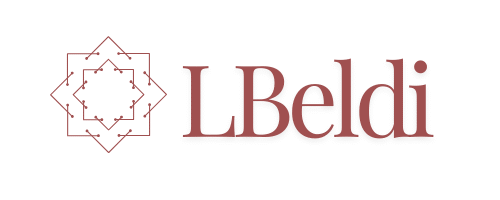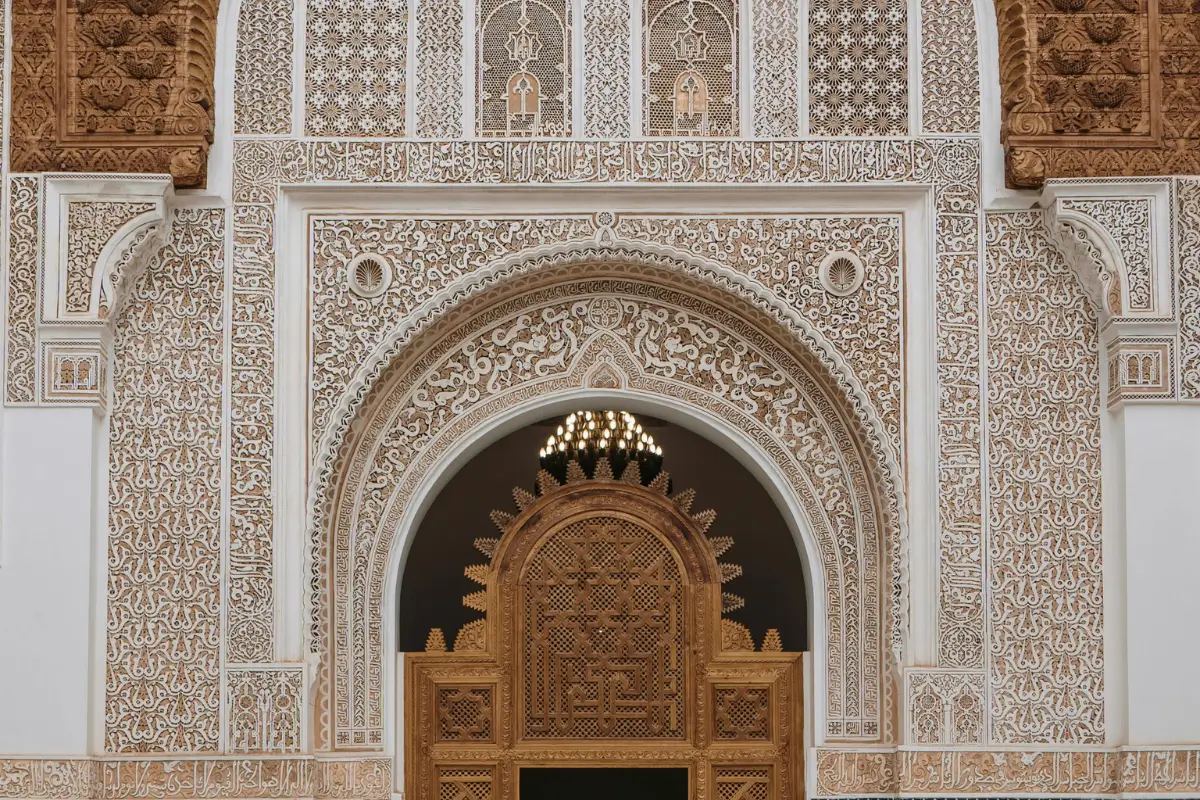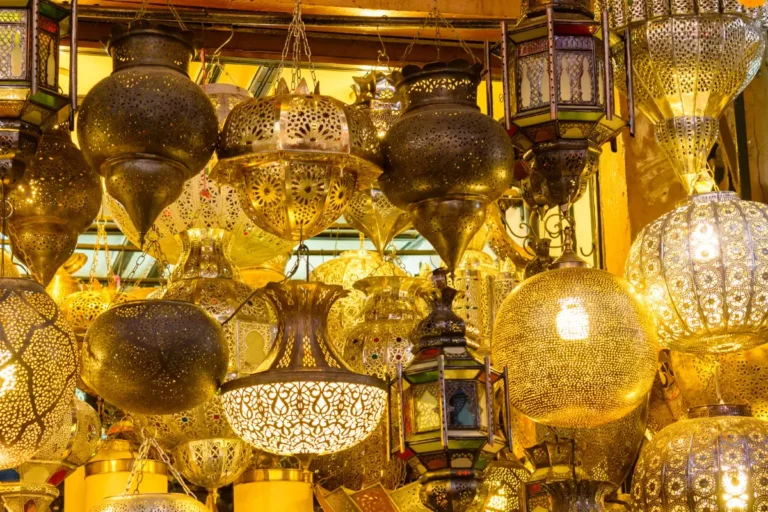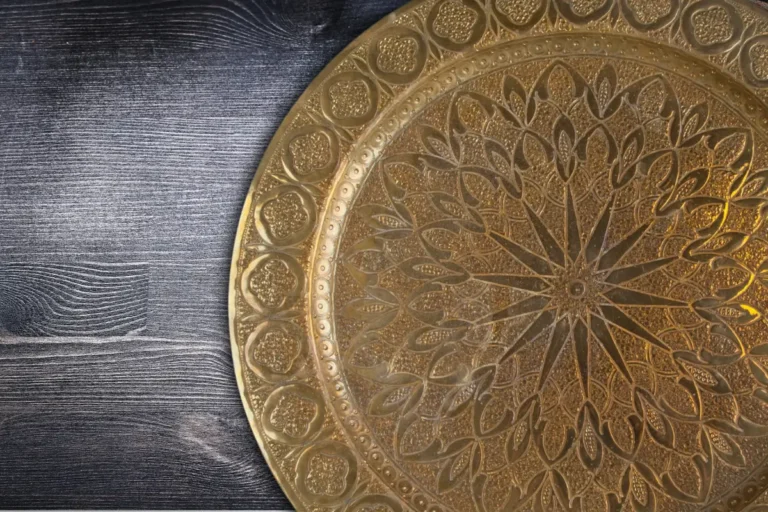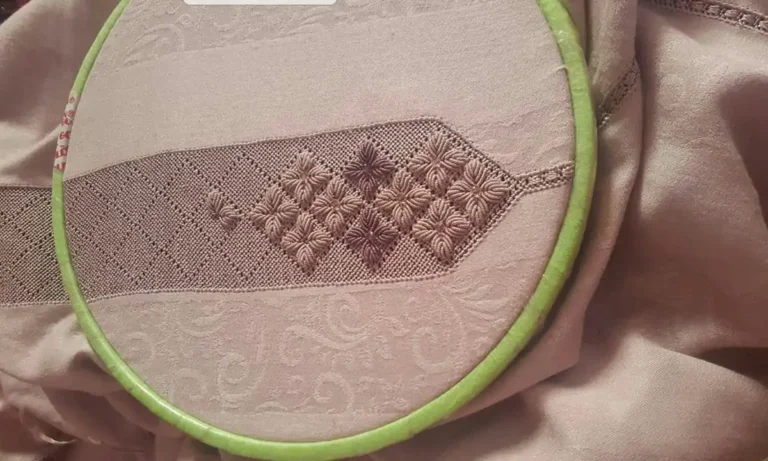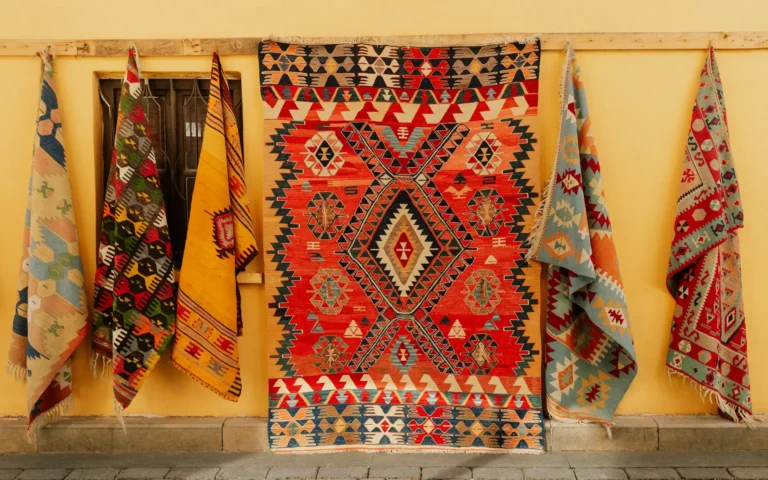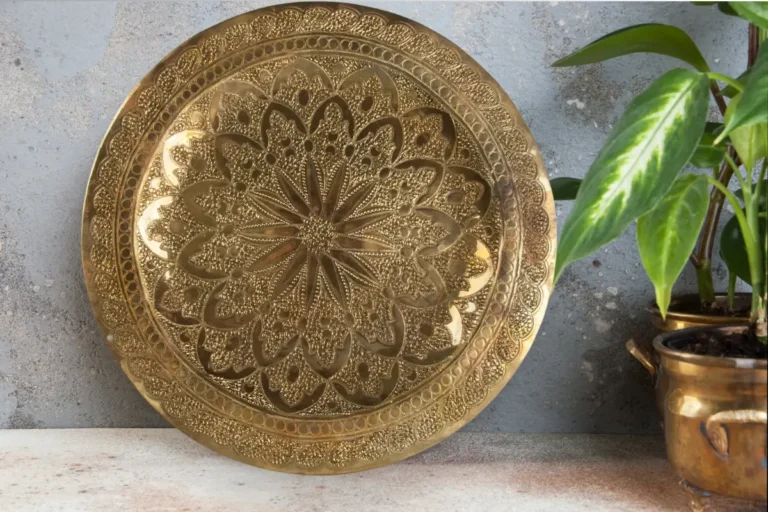Moroccan Gypsum Art: The Craftsmanship Behind Traditional Plaster Carving
Table of Contents
Introduction
Step into a Moroccan riad, and you’re immediately captivated by walls that are more than just surfaces; they are canvases alive with intricate patterns. This breathtaking artistry is the magic of Moroccan gypsum art, a cornerstone of the country’s rich artistic heritage. Far beyond mere decoration, it’s a testament to centuries of tradition, skill, and a profound reverence for beauty, transforming ordinary spaces into extraordinary realms.
This guide will uncover the secrets behind this mesmerizing craft: its history, delicate techniques of traditional plaster carving, the master artisans who preserve this legacy, and the deep symbolism woven into every curve. Prepare to be captivated by the enduring allure of Moroccan gypsum art, a true masterpiece of human ingenuity and devotion.
II. A Glimpse into History: The Roots of Traditional Moroccan Plasterwork
To appreciate Moroccan gypsum art, we must journey back to its origins, deeply intertwined with Islamic art and architecture. Flourishing during the Late Middle Ages, the art form is known as “Gebs” (الجبس), simply the Arabic word for gypsum.
The roots of traditional Moroccan plasterwork trace back to the Andalusian era in the Iberian Peninsula. Palaces in Granada, Cordoba, and Seville refined gypsum carving, and from there, the art migrated to North Africa, finding unique expression in Morocco. This migration wasn’t a simple transfer; it was a cultural assimilation, where Moroccan artisans imbued the craft with their unique aesthetic and spiritual interpretations, making it distinctly Moroccan.
The Almoravid dynasty (11th-12th centuries) significantly developed this art, laying groundwork for Moroccan architectural styles. Subsequent dynasties, particularly the Marinids (13th-15th centuries) and Saadians (16th-17th centuries), further refined techniques and elevated gebs to an unparalleled level of sophistication. The Marinids, known for their scholarly pursuits and grand madrasas, commissioned extensive plasterwork that showcased intricate geometric and calligraphic designs, reflecting their intellectual and spiritual aspirations. The Saadians, with their opulent palaces like El Badi in Marrakech, pushed the boundaries of decorative plasterwork, often combining it with other luxurious materials like marble and cedarwood to create breathtaking interiors.
The Alhambra in Granada, a 14th-century Nasrid palace, stands as an iconic example, its plasterwork inspiring artisans today. Its delicate stucco work, often featuring muqarnas (stalactite vaulting) and intricate arabesques, serves as a powerful reminder of the shared artistic heritage between Andalusia and Morocco. Many Moroccan maalems still draw inspiration from these historical masterpieces, studying their patterns and techniques to inform their own creations.
Within Morocco, historical sites like the 14th-century Al-Attarine Madrasa in Fes and the late 19th-century Bahia Palace in Marrakesh showcase the enduring legacy of gebs. The Al-Attarine Madrasa, a masterpiece of Marinid architecture, is renowned for its exquisite plasterwork, which covers almost every surface, creating an immersive experience of intricate beauty. The Bahia Palace, a more recent but equally impressive example, demonstrates the continued vitality of the craft, with its vast courtyards and reception halls adorned with stunning gebs designs. These structures are living museums, linking art, faith, and daily life, underscoring the profound cultural significance of traditional Moroccan plasterwork. They serve not only as architectural wonders but also as educational tools, allowing visitors to witness the evolution and enduring appeal of this remarkable art form.
III. The Art of Gebs: Understanding Moroccan Gypsum Carving
At the heart of this captivating art lies gypsum, a soft sulfate mineral. Its unique properties make it ideal for Moroccan gypsum carving.
When heated, gypsum becomes plaster of Paris; adding water creates a paste that hardens quickly. This rapid setting time is crucial: artisans carve the plaster while it’s wet and pliable, allowing for remarkable fluidity and precision. This contrasts with stone or wood, which require chiseling solid material. The malleability of wet plaster allows for the creation of incredibly fine details and delicate curves that would be impossible to achieve with harder materials, giving Moroccan gypsum art its distinctive ethereal quality.
The process begins by mixing gypsum powder with water to form a smooth paste, then applying it to a surface in layers (1-5 cm thick). The artisan must work swiftly and with absolute focus as the plaster sets. This immediacy demands deep understanding and an intuitive connection between hand and form. The quality of the gypsum powder is paramount; traditional maalems often source their gypsum from specific regions known for their high-purity deposits, ensuring the plaster’s workability and durability. The precise ratio of water to powder is also critical, as it directly impacts the setting time and the plaster’s consistency, which in turn affects the carving process.
This delicate balance between pliability and permanence gives Moroccan gypsum art its distinctive character. Each stroke is a commitment, a testament to the artisan’s mastery over a medium with little room for error. The result is a surface that, despite its delicate appearance, possesses remarkable durability, preserving intricate designs for generations. The hardened gypsum, once carved, becomes surprisingly resilient, capable of withstanding the test of time and maintaining its intricate beauty for centuries, as evidenced by the ancient examples still adorning historical buildings across Morocco.
IV. The Maalem: Masters of the Craft
Behind every breathtaking piece of Moroccan gypsum art is a “maalem,” a master artisan. These individuals embody centuries of tradition, dedicating their lives to perfecting the art of gebs. Their work is a profound dialogue between material and maker, transforming raw plaster into a tapestry of history and emotion.
Knowledge is typically passed down through familial lines, from father to son, or from master to apprentice. Young apprentices learn not just technical skills, but also the philosophy and reverence underpinning the art. This rigorous apprenticeship demands years of patient observation, tireless practice, and unwavering commitment, transcending mere trade to become a cultural identity. An apprentice might spend a decade or more under the tutelage of a maalem, starting with basic tasks like preparing the plaster and sharpening tools, gradually progressing to more complex carving techniques. This hands-on, immersive learning ensures that the subtle nuances and unspoken wisdom of the craft are faithfully transmitted across generations.
A maalem’s life is marked by ritual and deep respect for materials and tools. Before starting, they prepare their workspace with solemnity, often reciting prayers or blessings. The chisel, simple in form, becomes an extension of their hand, wielded with precision born of decades of experience. Carving is a meditation, each strike a testament to years mastering this difficult art. The rhythm of the chisel against the plaster, the subtle shifts in pressure, and the intuitive understanding of the material’s response are all part of this meditative process. It’s a dance between control and surrender, where the maalem allows the material to guide their hand while simultaneously imposing their artistic vision.
Imagine a maalem as a seasoned storyteller, the wet plaster their canvas. With each delicate cut, they weave narratives, preserve ancient symbols, and breathe life into patterns adorning Moroccan palaces and mosques for centuries. Their hands, guided by innate understanding, sculpt light and shadow, creating dynamic interplay and remarkable depth. This hand-carved gypsum art is a direct expression of their soul, infused with patience, devotion, and reverence. The subtle variations in depth and texture, the way light plays across the carved surfaces, and the overall harmony of the design all speak to the maalem’s profound connection to their craft and their cultural heritage.
In Moroccan culture, maalems hold revered status. They are keepers of heritage, custodians of a legacy stretching back through time. Though often unknown to the wider world, their work leaves an indelible mark on Morocco’s architectural identity, ensuring this ancient art thrives. They are silent heroes, bridging generations and preserving history, one exquisite carving at a time. Their workshops, often tucked away in the labyrinthine medinas of Fes or Marrakech, are living museums, where the echoes of centuries of craftsmanship resonate in every tap of the chisel and every swirl of plaster dust.
V. Intricate Designs: Patterns and Symbolism in Moroccan Stucco Art
Moroccan gypsum art’s captivating designs are a visual language, rooted in Islamic traditions and imbued with profound symbolism. The patterns in Moroccan stucco art blend geometric precision, organic fluidity, and sometimes calligraphy, creating balance, unity, and spiritual contemplation.
A. Geometric Patterns: The Language of Infinity
Geometric patterns are iconic in Moroccan plasterwork, mathematical marvels reflecting intellectual rigor and a spiritual quest for understanding infinity. Most Islamic patterns use four-fold or six-fold geometry (squares, hexagons) that interlock seamlessly. This allows endless variations, playing with contrast and color. These patterns are not merely decorative; they are philosophical statements, representing the infinite nature of God and the underlying order of the universe. The repetition and symmetry found in these designs evoke a sense of harmony and balance, inviting contemplation and reflection.
Emphasis is often on the underlying grid or frame, creating an interlace effect like a woven tapestry. Lines appear to weave in and out, encouraging viewers to trace them and meditate on divine order. They are a visual interpretation of infinity. Examples include the intricate star patterns, often seen in ceilings and wall panels, which can be composed of 8, 12, or even 16 points, each radiating from a central point, symbolizing the interconnectedness of all creation. The complexity of these patterns often belies their underlying mathematical simplicity, a testament to the ingenuity of the artisans who developed them.
B. Arabesque and Floral Motifs: Nature’s Embrace
Contrasting geometric precision, Moroccan gypsum art embraces arabesque and floral motifs, bringing warmth and familiarity. These designs evoke nature’s graceful forms: intertwining vines, delicate leaves, and blossoms cascade across surfaces, creating a garden frozen in time. The arabesque, a flowing, curvilinear pattern, is a hallmark of Islamic art, symbolizing the endless growth and renewal of life. These motifs are often highly stylized, abstracting natural forms into elegant, rhythmic compositions.
Characterized by flowing lines and rhythmic repetitions, arabesques avoid depicting living beings, focusing on abstract, stylized plant forms. This emphasizes natural growth and interconnectedness. Floral designs, while softer, maintain order and balance, often integrating with geometric frameworks. Common floral motifs include the palmette, the lotus, and various types of rosettes, each rendered with exquisite detail and precision. The interplay between the geometric and the organic creates a dynamic visual tension, where the strict order of geometry is softened by the fluid beauty of nature.
This interplay between structured and fluid, intellectual and emotional, is where Moroccan plasterwork finds its unique language, speaking directly to the heart and soul. It’s a visual symphony where the precision of mathematics meets the poetry of nature, resulting in an art form that is both intellectually stimulating and aesthetically captivating.
C. Calligraphy: The Word Made Beautiful
Calligraphy holds a significant place in Islamic architectural plaster motifs, though less prevalent in pure carving. Verses from the Quran, blessings, or poetic phrases are integrated into designs, particularly in mosques and madrasas. These calligraphic elements are art themselves, flowing script becoming integral to the decorative scheme. The beauty of the script enhances the spiritual message, making walls literally speak with divine wisdom. The combination of geometry, arabesque, and calligraphy culminates in a rich, multi-layered aesthetic. Different calligraphic styles, such as Kufic, Thuluth, and Naskh, are employed, each with its own distinct characteristics and historical significance. The choice of script often depends on the context and the message being conveyed, adding another layer of meaning to the already rich tapestry of Moroccan gypsum art.
VI. Techniques of Traditional Plaster Carving
Moroccan gypsum carving demands artistic vision, material understanding, and precise execution. Techniques employed by maalems, honed over centuries, remain largely unchanged, emphasizing enduring wisdom.
The Plaster Preparation: A Race Against Time
Preparation begins with mixing high-quality gypsum powder with water to form a thick, consistent paste. This is critical, as gypsum plaster sets quickly. The artisan must work swiftly, applying plaster in sections (1-5 cm thick) to a perfectly smooth surface. Any imperfections will be magnified. The ideal consistency of the plaster is crucial; it must be fluid enough to spread evenly but thick enough to hold its shape during carving. This delicate balance is often achieved through years of experience and an intuitive understanding of the material.
The Tools: Simple Yet Powerful
Tools are remarkably simple: various chisels, mallets, and specialized knives. Hand-held chisels allow direct, tactile connection. Their simplicity belies the extraordinary detail they produce. These tools are often handmade by the maalems themselves, or by specialized blacksmiths, ensuring they are perfectly suited to the specific demands of gypsum carving. The variety of chisels, from broad flat ones for rough shaping to fine-pointed ones for intricate details, allows the maalem to achieve a wide range of textures and effects.
The Carving Process: Sculpting Light and Shadow
Once plaster is applied and firm but pliable, carving begins. Designs are traced or, often, worked freehand, a hallmark of authentic Moroccan plasterwork. The ability to carve freehand, without the aid of stencils or templates, is a true mark of a master maalem, demonstrating their profound understanding of geometric principles and their innate artistic talent. The carving is a delicate excavation: the artisan establishes a line and excavates towards it, creating crisp edges and varying depths crucial for light and shadow play. Each cut is deliberate, precise, with little room for error. The maalem must anticipate how the light will interact with the carved surfaces, using varying depths to create a dynamic interplay of light and shadow that brings the design to life.
Imagine the maalem as a sculptor of light and shadow, manipulating the surface to catch and reflect light, creating dynamic visual experiences. Varying depths create a bas-relief effect, where elements emerge from the surface, giving a subtle yet profound three-dimensional quality. This meticulous process transforms a flat surface into a living work of art, a testament to hand-carved gypsum art. The final result is not just a flat pattern, but a sculptural masterpiece that changes with the light, revealing new details and nuances throughout the day.
VII. Where to Find Moroccan Gypsum Art: Architectural Marvels
Moroccan gypsum art is integral to the country’s architecture, transforming buildings into breathtaking works. To appreciate its grandeur, experience it within its designed spaces, from palaces to intimate riads.
Palaces and Mosques: Grand Canvases of Gebs
Magnificent displays are found in grand palaces and historic mosques. These structures feature expansive surfaces for elaborate plaster carvings. Royal Palaces in Fes and Rabat, though often inaccessible, house fine examples. Mosques showcase exquisite islamic architectural plaster motifs, framing mihrabs, minbars, and archways with calligraphic, geometric, and floral designs. The Koutoubia Mosque in Marrakech and Hassan II Mosque in Casablanca demonstrate its continued relevance. The sheer scale and complexity of the plasterwork in these grand structures are awe-inspiring, reflecting the power and devotion of the patrons who commissioned them. The mihrab, a niche in the wall of a mosque that indicates the direction of Mecca, is often the most elaborately decorated element, serving as a focal point for prayer and contemplation.
Riads and Madrasas: Intimate Spaces of Beauty
In riads, traditional Moroccan houses with courtyards, gypsum art creates a peaceful ambiance. Stunning moroccan riad plaster decoration adorns courtyards, living rooms, and private chambers. Intricate decorative plaster ceiling designs transform rooms into jewel boxes. Madrasas, like Al-Attarine Madrasa in Fes, are treasure troves of gebs, with meticulously carved surfaces designed for learning and contemplation. The intimate scale of riads allows for a more personal experience of the art, where every corner reveals a new detail, inviting closer inspection. The courtyards, often open to the sky, provide natural light that enhances the beauty of the carved plaster, creating a serene and contemplative atmosphere.
Gypsum Arches and Cornices: Structural Elegance
Moroccan gypsum art enhances architectural elements like arches and cornices. Gypsum arches and cornices are often intricately carved, adding sculptural elegance to doorways, windows, and ceiling transitions. They serve both structural and decorative purposes, blending form and function. Light playing on carved surfaces creates dynamic visual effects, highlighting depth and artistry. These elements not only provide structural support but also serve as visual transitions, guiding the eye from one space to another, and adding a sense of grandeur and sophistication to the interior.
Interplay with Other Moroccan Art Forms
Moroccan interiors uniquely blend various traditional art forms. Gypsum art often complements vibrant zellige (tilework), carved cedarwood, and polished tadelakt (lime plaster). The delicate plasterwork contrasts with rich tile hues and warm wood tones, creating a multi-sensory experience. This synergy elevates Moroccan architecture to an art form, a testament to the country’s dedication to beauty and tradition. The vibrant colors of zellige, the rich aroma of cedarwood, and the smooth, tactile surface of tadelakt all combine with the intricate gypsum carvings to create a harmonious and immersive environment that engages all the senses.
VIII. Preserving a Legacy: Modern Relevance and Challenges
Preserving traditional crafts like Moroccan gypsum art faces both opportunities and challenges. This ancient art, deeply rooted in history, is vital to Morocco’s identity, and efforts are made to ensure its survival.
The Importance of Preservation
Preserving Moroccan gypsum art is crucial as it links to the country’s past, embodying centuries of heritage. Losing it means losing a significant piece of Moroccan history and cultural memory. It represents unique artistic expression, showcasing craftsmanship and dedication rare in mass production. Each piece is a testament to human skill. Beyond its cultural value, the preservation of gebs also has economic implications, as it supports a community of skilled artisans and contributes to Morocco’s tourism industry. It’s a living heritage that continues to inspire and captivate.
Furthermore, gebs contributes to Morocco’s tourism, drawing visitors and providing livelihoods for artisans, supporting local economies. Preserving this legacy sustains culture, economy, and identity. International recognition and appreciation for Moroccan art forms, including gypsum carving, have also played a role in its preservation, encouraging both local and global efforts to support the craft.
Modern Applications and Integration
Moroccan gypsum art adapts to contemporary aesthetics while retaining its essence. Many modern Moroccan homes, hotels, and international projects incorporate traditional plasterwork, often as accents. This demonstrates its timeless appeal and versatility. Designers and architects are increasingly seeking out authentic, hand-crafted elements to add character and warmth to their projects, and Moroccan gypsum art fits this need perfectly. Its intricate patterns and delicate textures can create a striking contrast with minimalist designs, adding a touch of exotic elegance.
Designers seek authentic, hand-crafted elements to add character. Moroccan gypsum panels, decorative plaster ceiling designs, and intricate cornices create focal points, adding warmth and elegance to modern interiors. This blend of old and new ensures the craft remains relevant. For example, a contemporary living room might feature a single wall adorned with a traditional gypsum carving, or a modern hotel lobby might incorporate intricately carved gypsum arches, seamlessly blending traditional craftsmanship with modern design sensibilities.
Challenges Faced by Artisans Today
Despite its appeal, challenges exist. A primary concern is the dwindling number of young apprentices due to the lengthy, rigorous apprenticeship and modest financial returns. This threatens knowledge transfer. The traditional apprenticeship model, while effective, can be a deterrent for younger generations seeking quicker financial independence. Efforts are being made to establish training centers and provide financial incentives to encourage more young people to pursue this ancient craft.
Another challenge is cheaper, mass-produced alternatives that mimic appearance but lack soul and authenticity, creating economic pressure on maalems. Availability of high-quality raw materials and environmental factors also impact production. Maintaining material and technique integrity is paramount. The rise of machine-made imitations poses a significant threat to the authenticity and value of hand-carved gypsum art. Educating consumers about the difference between genuine hand-crafted pieces and mass-produced imitations is crucial for supporting the maalems.
Organizations and patrons support artisans, promote their work, and educate the public about authentic Moroccan gypsum art. By fostering appreciation and sustainable markets, this magnificent legacy can thrive for generations. Initiatives such as artisan cooperatives, cultural festivals, and online platforms are helping to connect maalems with a wider audience, ensuring that their extraordinary skills continue to be valued and preserved.
IX. TIPS for Appreciating and Incorporating Moroccan Gypsum Art
Moroccan gypsum art is a feast for the eyes. Whether you’re an admirer or looking to infuse your space with Moroccan elegance, here are tips to enhance appreciation and consider integration:
For the Art Enthusiast:
•Look Closely at the Details: Observe intricate patterns, subtle depth variations, light and shadow play, and precision. Beauty is in the minute details. Take your time to trace the lines with your eyes, noticing how the patterns interlock and flow, and how the light and shadow create a sense of movement and depth.
•Understand the Symbolism: Familiarize yourself with motifs (geometric, arabesque, floral) and their symbolism. Knowing a geometric pattern represents infinity or a floral motif signifies nature’s abundance deepens appreciation. This understanding adds a layer of intellectual engagement to the visual experience, allowing you to connect with the deeper meanings embedded in the art.
•Seek Out Authentic Examples: Visit Morocco and explore historical sites like Al-Attarine Madrasa or Bahia Palace. Experiencing the art in its original context provides unparalleled understanding. The atmosphere of these historical sites, combined with the grandeur of the plasterwork, creates an unforgettable experience that truly brings the art to life.
•Support Artisans: If purchasing, seek reputable sources supporting traditional maalems and ethical practices. This preserves the craft and ensures genuine art. Look for certifications or labels that guarantee authenticity and fair trade, and consider visiting artisan workshops directly to witness the creation process firsthand.
For Incorporating into Modern Design:
•Accent Walls: Consider a single accent wall with hand-carved gypsum art. This creates a stunning focal point, blending traditional charm with contemporary minimalism. The intricate patterns can add texture and visual interest to an otherwise simple space, creating a unique and sophisticated aesthetic.
•Decorative Panels: Smaller, framed panels can be wall hangings, offering a taste of beauty. These can be custom-made to fit specific dimensions or design preferences, allowing for flexibility in incorporating the art into various spaces. They can also be used as decorative screens or room dividers, adding a touch of Moroccan elegance without overwhelming the space.
•Ceiling Medallions and Cornices: For subtle elegance, incorporate decorative plaster ceiling designs or intricate cornices. These add architectural interest and luxury, reminiscent of riads. Even a small gypsum medallion around a light fixture can elevate the entire room, adding a touch of traditional Moroccan charm to a modern interior.
X. Frequently Asked Questions About Moroccan Gypsum Art
Here are answers to some common questions about this fascinating art form:
Q1: What is Moroccan gypsum art?
Moroccan gypsum art, also known as “gebs” or traditional Moroccan plasterwork, is an ancient, intricate decorative art involving carved gypsum plaster. It’s a cornerstone of Moroccan architecture, characterized by elaborate geometric, arabesque, and floral patterns, found on walls, ceilings, arches, and cornices in palaces, riads, mosques, and madrasas. It’s a testament to centuries of artistic tradition and skilled craftsmanship.
Q2: How is Moroccan gypsum art made?
It’s primarily hand-carved by skilled artisans (“maalems”). Gypsum powder is mixed with water to create a pliable paste, applied to a surface. While wet, the maalem meticulously carves designs using simple hand tools. The rapid setting time requires immense skill, precision, and speed, as the artisan must complete the carving before the plaster hardens. This traditional method ensures the unique character and authenticity of each piece.
Q3: Where can I see authentic Moroccan gypsum art?
Throughout Morocco, especially in Fes, Marrakesh, and Rabat. Notable examples include Al-Attarine Madrasa (Fes) and Bahia Palace (Marrakesh), plus various traditional riads and mosques. High-end hotels also feature contemporary interpretations. Many historical sites offer guided tours that highlight the intricate plasterwork, providing insights into its history and symbolism.
Q4: What are the common motifs in Moroccan plasterwork?
•Geometric Patterns: Intricate interlocking designs based on mathematical principles, symbolizing infinity and divine order. These often feature stars, polygons, and interlacing lines.
•Arabesque and Floral Motifs: Flowing, organic patterns with stylized vines, leaves, and blossoms, representing nature and spiritual connection. These are characterized by their curvilinear forms and rhythmic repetitions.
•Calligraphy: Less dominant in pure carving, but calligraphic inscriptions (often Quranic verses or blessings) are sometimes integrated, transforming text into beautiful artistic elements. Different Arabic scripts are used, each with its own aesthetic appeal.
Q5: Is Moroccan gypsum art durable?
Yes, despite its delicate appearance, well-executed Moroccan gypsum art is surprisingly durable. Once hardened, it forms a robust surface. However, it can be susceptible to damage from impact, excessive moisture, or extreme temperature fluctuations. With proper care and maintenance, it can last centuries, as seen in ancient examples across Morocco, standing as a testament to its enduring quality.
XI. Conclusion: A Timeless Masterpiece
Moroccan gypsum art is far more than a decorative craft; it’s a living testament to a rich cultural heritage, an expression of artistic devotion, and a timeless masterpiece. From its historical roots to its flourishing in Morocco’s architecture, gebs has evolved while retaining its essence.
The intricate geometric patterns, flowing arabesques, and delicate floral motifs are a visual language of harmony, infinity, and spiritual connection. At its heart are the maalems, master artisans who transform simple minerals into breathtaking art. Each hand-carved gypsum art piece is a unique signature, imbued with the soul of its creator, reflecting their skill, patience, and profound understanding of the material.
In a world that often rushes, Moroccan gypsum art reminds us of the value of patience, precision, and the profound beauty born from purpose and heart. It’s a bridge between past and present, carrying Morocco’s cultural essence forward, inspiring new generations of artisans and admirers alike.
So, next time you encounter Moroccan plasterwork, pause. Look closely. Feel the history. Appreciate the skill. In every line, you’ll find not just gypsum, but the enduring spirit of Morocco – carved in plaster, etched into the very soul of a nation.
Did you find this article helpful?
Rate it now and help us deliver better content:
There are no reviews yet. Be the first to share your feedback!
